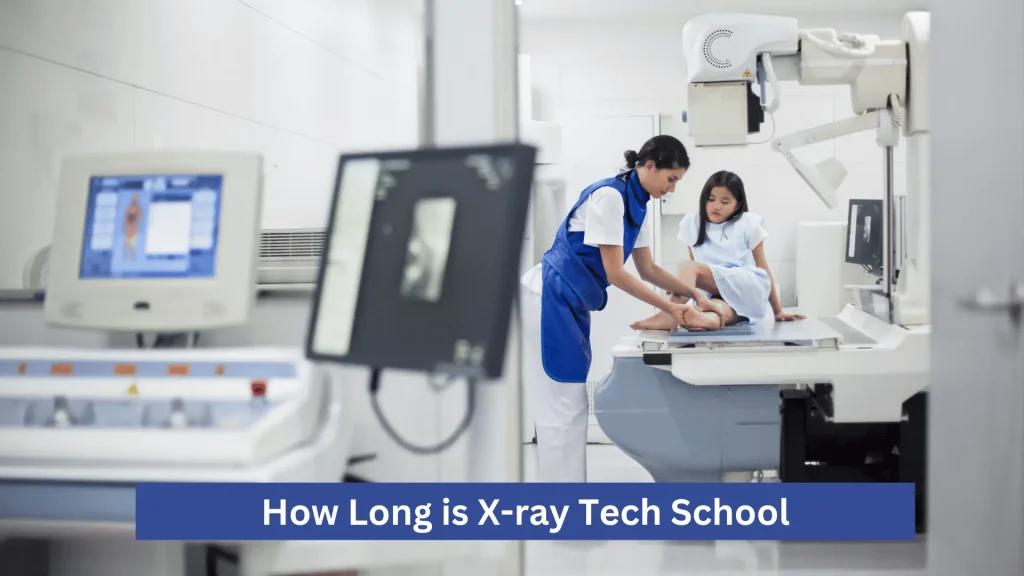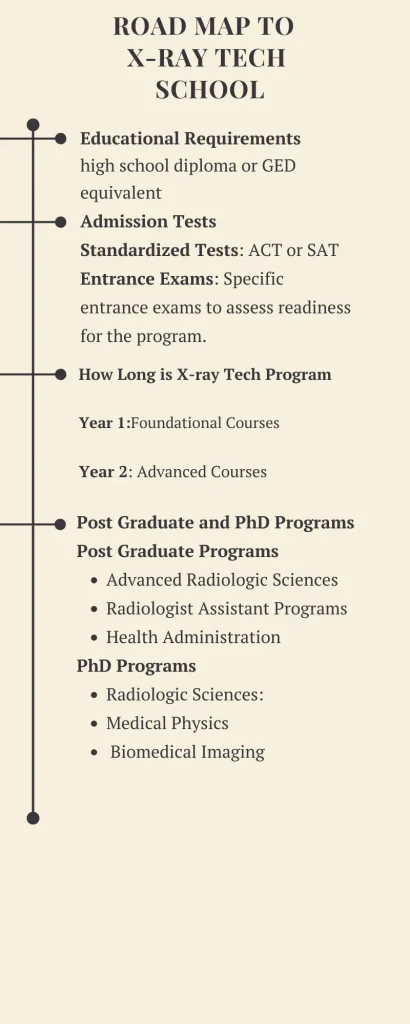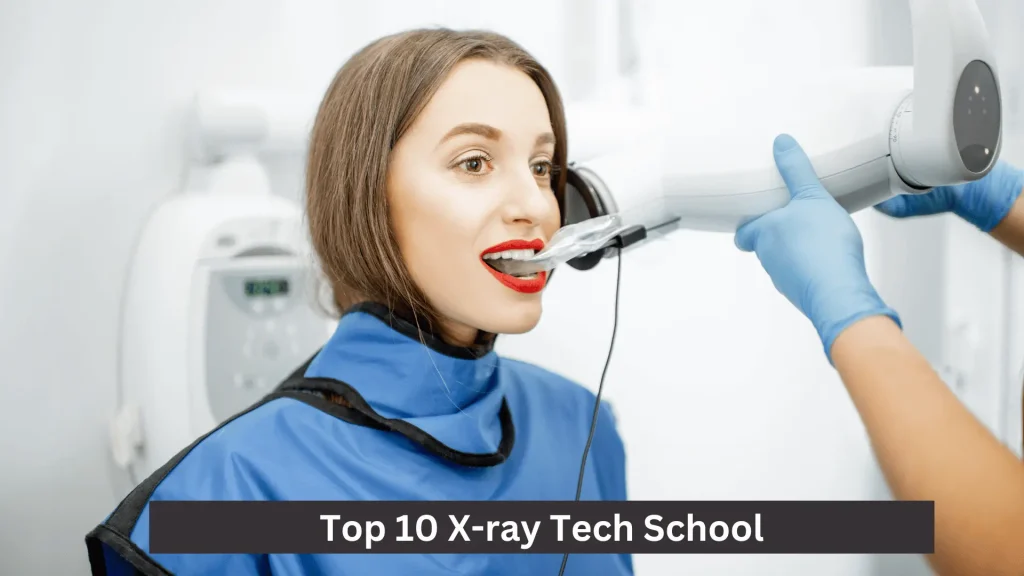How Long X-Ray Tech School
Typically, X-ray tech programs span about two years for an associate degree, though certificate programs may take as little as one year. The duration varies based on full-time or part-time enrollment and clinical training requirements. Explore How Long X-Ray Tech School suits your career goals.
What is X-ray Tech School
X-ray tech school prepares students to operate imaging equipment, assisting in diagnosing medical conditions. Programs cover anatomy, patient care, radiation safety, and imaging techniques. Typically lasting 1-2 years, X-ray tech schools offer certificates or associate degrees.

Clinical training is integral, allowing students to apply classroom knowledge in real-world settings. Graduates can pursue careers in hospitals, clinics, or diagnostic imaging centers. Understanding what X-ray tech school entails ensures you choose a program aligned with your career aspirations and educational needs.
How Long X-Ray Tech School
An undergraduate program in radiologic technology, commonly referred to as X-ray tech school, typically spans two to four years, depending on the degree pursued (Associate or Bachelor’s). Here’s a detailed breakdown of what you might expect each year:
Year 1: Foundation and Introduction
Courses:
- Introduction to Radiologic Technology: Overview of the radiologic technology field, including history, ethics, and professional responsibilities.
- Anatomy and Physiology: Detailed study of the human body, focusing on structures and functions relevant to radiologic technology.
- Medical Terminology: Essential terminology used in the medical and radiologic fields.
- Patient Care and Management: Basics of patient interaction, safety, and comfort in a clinical setting.
- Basic Radiographic Procedures: Introduction to radiographic positioning and techniques.
Focus:
- Establishing a strong foundation in medical and radiologic principles.
- Learning the basic skills needed for patient care and initial radiographic procedures.
- Understanding the professional and ethical standards of the field.
Year 2: Core Radiologic Technology
Courses:
- Advanced Radiographic Procedures: In-depth study of positioning, techniques, and procedures for various types of radiographic exams.
- Radiographic Imaging: Principles of image production, including exposure factors, image quality, and digital imaging.
- Radiation Protection and Biology: Understanding radiation safety principles and the biological effects of radiation.
- Radiographic Pathology: Study of diseases and conditions as they appear on radiographic images.
- Clinical Practicum I: Hands-on experience in a clinical setting under supervision, applying learned skills in real-world scenarios.
Focus:
- Building on foundational knowledge with advanced radiographic techniques and procedures.
- Gaining practical experience through clinical rotations.
- Emphasizing radiation safety and understanding the pathology relevant to radiologic technology.
Year 3: Specialization and Advanced Topics (For Bachelor’s Degree Programs)
Courses:
- Sectional Anatomy: Detailed study of cross-sectional anatomy using imaging modalities like CT and MRI.
- Advanced Imaging Modalities: Introduction to advanced imaging technologies such as CT, MRI, and ultrasound.
- Health Care Law and Ethics: In-depth study of legal and ethical issues in healthcare and radiologic technology.
- Quality Management: Principles of quality assurance and quality control in radiographic imaging.
- Clinical Practicum II: Continued hands-on experience with increasing responsibility and complexity in clinical settings.
Focus:
- Expanding knowledge into specialized and advanced imaging modalities.
- Understanding the legal and ethical complexities of healthcare.
- Continuing to develop clinical skills with more advanced procedures and patient interactions.
Year 4: Integration and Capstone (For Bachelor’s Degree Programs)
Courses:
- Radiologic Technology Capstone: Integrative project or research in radiologic technology, synthesizing knowledge from the entire program.
- Advanced Patient Care: Focused study on advanced patient care techniques and considerations.
- Health Care Management: Introduction to management principles in a healthcare setting, including leadership, administration, and healthcare economics.
- Electives in Specialized Areas: Courses in areas of interest such as interventional radiology, mammography, or nuclear medicine.
- Clinical Practicum III: Final clinical rotation with a focus on independent practice and preparation for certification exams.
Focus:
- Synthesizing and applying comprehensive knowledge and skills in a capstone project or research.
- Preparing for leadership roles or further specialization in the field.
- Final preparation for certification and entry into the professional workforce.

How to Enter X-ray Tech School
Educational Requirements
High School Diploma or Equivalent: Completion of high school with courses in math, science, and English.
Prerequisite Courses: Some programs may require completion of specific college-level courses in anatomy, physiology, and medical terminology.
Entry Tests
Standardized Tests: Some programs may require SAT or ACT scores.
Entrance Exams: Certain schools may have specific entrance exams to assess readiness for the program.
Application Process
Research Programs: Identify accredited X-ray tech programs that fit your career goals and educational needs.
Complete Application: Submit an application form, along with transcripts, test scores, and any required essays or personal statements.
Letters of Recommendation: Obtain letters from teachers, employers, or professionals in the field.
Interview: Some programs may require an interview as part of the admission process.
Financial Aid
Scholarships: Look for scholarships specifically for radiologic technology students.
Grants: Apply for federal and state grants, such as the Pell Grant.
Student Loans: Federal and private loans can help cover tuition and other expenses.
Work-Study Programs: Opportunities to work part-time while attending school to offset costs.
Post Graduate and PhD Programs for X-Ray Tech School
Post Graduate Programs:
- Advanced Radiologic Sciences: Focuses on advanced imaging techniques, healthcare management, and leadership roles in radiology.
- Radiologist Assistant Programs: Prepares technologists to perform more complex procedures and assist radiologists with diagnostic tasks.
- Health Administration: Equips graduates with skills to manage radiology departments or healthcare facilities.
PhD Programs:
- Radiologic Sciences: Involves advanced research in imaging technologies, radiation safety, and radiologic education.
- Medical Physics: Focuses on the application of physics to medicine, particularly in diagnostic imaging and radiation therapy.
- Biomedical Imaging: Covers the development and improvement of imaging techniques and technologies used in medical diagnostics.
Top 10 X-Ray Tech Schools
Selecting the top X-ray tech schools involves considering factors such as program accreditation, clinical training opportunities, faculty expertise, and overall reputation. Here are ten highly regarded schools offering radiologic technology programs in the United States:

Mayo Clinic School of Health Sciences
Location: Rochester, Minnesota
Known for: Comprehensive clinical training and access to Mayo Clinic facilities.
Johns Hopkins University
Location: Baltimore, Maryland
Known for: Cutting-edge medical research and extensive clinical training.
Ohio State University
Location: Columbus, Ohio
Known for: Strong emphasis on research and clinical practice, with state-of-the-art facilities.
University of California, San Francisco (UCSF)
Location: San Francisco, California
Known for: Exceptional clinical training in a leading medical center.
University of Iowa
Location: Iowa City, Iowa
Known for: Highly regarded radiologic technology program with robust clinical rotations.
Massachusetts General Hospital Institute of Health Professions
Location: Boston, Massachusetts
Known for: Strong affiliation with Massachusetts General Hospital, providing excellent clinical experience.
University of North Carolina at Chapel Hill
Location: Chapel Hill, North Carolina
Known for: Comprehensive program with access to top-notch medical facilities.
University of Southern California (USC)
Location: Los Angeles, California
Known for: Strong emphasis on both academic excellence and clinical experience.
Northwestern Memorial Hospital School of Radiography
Location: Chicago, Illinois
Known for: Intensive clinical training and affiliation with Northwestern Memorial Hospital.
Emory University
Location: Atlanta, Georgia
Known for: Comprehensive radiologic technology program with excellent clinical opportunities.
Factors Affecting the Length of X-Ray Tech School
Program Type:
Certificate Programs: Typically take about 1 year to complete.
Associate Degree Programs: Generally span 2 years.
Bachelor’s Degree Programs: Can take 4 years to complete.
Enrollment Status:
Full-Time vs. Part-Time: Full-time students complete the program faster than part-time students.
Accelerated Programs: Some schools offer accelerated programs that shorten the duration.
Clinical Training Requirements:
Mandatory Clinical Hours: Programs with extensive clinical requirements may take longer.
Availability of Clinical Sites: Limited availability can extend the program duration.
Prerequisite Courses:
Completion Time: Time required to complete prerequisite courses can affect overall duration.
Concurrent vs. Sequential: Whether prerequisites are taken concurrently with the program or before enrollment.
Institutional Factors:
Curriculum Structure: The way the curriculum is organized can impact the length.
Program Flexibility: Flexible scheduling options may alter the program duration.
Final Verdict
X-ray tech school offers a range of programs from certificates to advanced degrees, each varying in duration. Understanding the requirements, application process, and available financial aids can help you make an informed decision. Choosing the right program will set the foundation for a successful career in radiologic technology.
FAQs
1.How long does it take to complete X-ray tech school?
Certificate programs typically take about 1 year, while associate degrees take 2 years and bachelor’s degrees take 4 years.
2.What are the educational requirements for X-ray tech school?
A high school diploma or equivalent, often with prerequisite courses in math, science, and English.
3.What kind of financial aid is available for X-ray tech students?
Scholarships, grants, student loans, and work-study programs are commonly available to help cover tuition and other expenses.
4.What is the application process for X-ray tech school?
Research programs, complete application forms, submit transcripts and test scores, provide letters of recommendation, and possibly attend an interview.
5.Are there advanced degrees available for X-ray techs?
Yes, there are post-graduate programs and PhD programs in advanced radiologic sciences, medical physics, and biomedical imaging.
